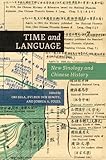Time and Language : New Sinology and Chinese History / ed. by Joshua A. Fogel, Ori Sela, Zvi Ben-Dor Benite.
Material type: TextPublisher: Honolulu : University of Hawaii Press, [2023]Copyright date: ©2023Description: 1 online resource (280 p.) : 1 b&w illustrationContent type:
TextPublisher: Honolulu : University of Hawaii Press, [2023]Copyright date: ©2023Description: 1 online resource (280 p.) : 1 b&w illustrationContent type: - 9780824894580
- 950
- online - DeGruyter
| Item type | Current library | Call number | URL | Status | Notes | Barcode | |
|---|---|---|---|---|---|---|---|
 eBook
eBook
|
Biblioteca "Angelicum" Pont. Univ. S.Tommaso d'Aquino Nuvola online | online - DeGruyter (Browse shelf(Opens below)) | Online access | Not for loan (Accesso limitato) | Accesso per gli utenti autorizzati / Access for authorized users | (dgr)9780824894580 |
Frontmatter -- Contents -- Introduction: Time, Text, and History in China -- 1 Tulišen’s Embassy to Distant Territories: The Travels of a Text -- 2 Struggles over the Historical Memory of a Heterodoxy: Chinese Commentaries on the Nestorian Stele -- 3 How Much Does an Understanding of History Help? Naitō Konan’s Reading of “Communism” in China -- 4 To “Turn the Historical Clock Back”: Past, Text, and the Politics of Yuan Shikai’s Monarchy -- 5 Wenxue and New Practices of Writing in Post-1840 China -- 6 Cai Yuanpei’s Politico-Philosophical Languages -- 7 Vernacular Knowledge in Time: Sinology outside the Archive -- 8 In Search of a Standard National Language in Republican China -- 9 A Guangxu Renaissance? Manchu Language Studies in the Late Qing and Their Republican Afterlife -- 10 The Textual Time Machine: Truth, Facts, and the Shuowen, 1770–1932 -- 11 A Time to Heal or a Time to Kill: Confessions in the Anti-Shaman Campaign at Communist Yan’an, 1944–1945 -- Bibliography -- Contributors -- Index
restricted access online access with authorization star
http://purl.org/coar/access_right/c_16ec
China’s past and present have been in a continuous dialogue throughout history, one that is heavily influenced by time and language: the temporal orientation and the linguistic apparatus used to express and solidify identity, ideas, and practices. Presenting a host of in-depth case studies, Time and Language: New Sinology and Chinese History argues for and demonstrates the significance of “New Sinology” by restoring the role of language/philology in the research and understanding of how modern China emerged. Reading the modern as a careful and ongoing conversation with the past renders the “new” in a different perspective. This volume is a significant step toward a new historical narrative of China’s modern history, one wherein “ruptures” can exist in tandem with continuities. The collection accentuates the deep connection between language and power—one that spans well across China’s long past—and hence the immense consequences of linguistic-related methodology to the comprehension of power structures and identity in China.Each of the essays in this volume tackles these issues, the methodological and the thematic, from a different angle but they all share the Sinological prism of analysis and the basic understanding that a much longer timeframe is required to make sense of Chinese modernity. The languages examined are diverse, including modern and classical Chinese, as well as Manchu and Japanese. Taken together they bring a spectrum of linguistic perspectives and hence a spectrum of power relations and identities to the forefront. While the essays focus on late Qing and early twentieth-century eras, they refer often to earlier periods, which are necessary to making real sense of later eras. The methodological and the thematic do not only converge, but also generate a plea for fostering and expanding this approach in current and future studies.
Mode of access: Internet via World Wide Web.
In English.
Description based on online resource; title from PDF title page (publisher's Web site, viewed 06. Mrz 2024)


